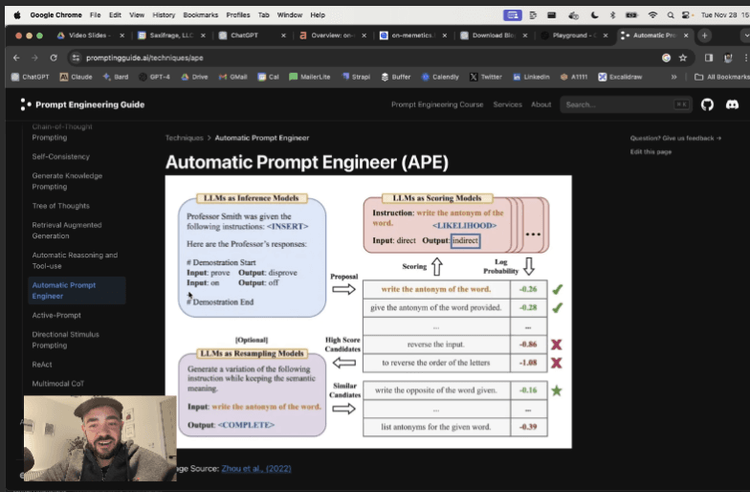My employees aren't good at prompting
It's funny because even when AI saves me 10 hours, I still resent the 10 minutes it took to figure out the prompt.
Automatic Prompt Engineer
GPT-4 is a human-level prompt engineer, and can automate prompt engineering just like it can automate any other task...More
We need to find a way to generate prompts that accurately describe what we need and that our chatbot can understand.
I know we've been discussing automatic prompt engineering, but does anyone have any other ideas on how we could get this done quickly and efficiently?
We don't have a lot of time to waste. Let's get creative!
This course is a work of fiction. Unless otherwise indicated, all the names, characters, businesses, data, places, events and incidents in this course are either the product of the author's imagination or used in a fictitious manner. Any resemblance to actual persons, living or dead, or actual events is purely coincidental.
Automatic Prompt Engineer (APE) is a technique for using GPT-4 to automate their prompts. APE uses GPT-43 to infer instructions from example responses and specific instructions, and then ranks the potential responses with probabilities. This technology has enabled the automation of a variety of tasks in the prompt engineering domain.
The concept of APE was first introduced in a paper by the name of Automatic Prompt Engineer. Here, they used ChatGPT to infer what the instructions were. They then returned a lot of probabilities to the potential responses, and then ranked them. It was found that APE was at a human level in terms of prompt engineering.
Since then, there have been a few other papers that have come out, including one that found a better step-by-step prompt. This was used widely on the internet, and it was also using an automatic prompt engineer. The basics of this technology were found in an open source tool called Prompts Royale, which references another paper. This paper utilizes a different approach to APE.
Within APE, the prompt template has to be given. This includes best practices and variables. For example, when creating a list of product names, the product description variable is included in the template, along with some example values. It is also important to include criteria evaluation, such as helpful, insightful, and inappropriate. Additionally, prompt engineering best practices should be used.
Once the template is submitted, it is automatically generated based on the variables given. This works best with GPT4, and the temperature should be set to one. It is also important to label the placeholders in the template, as this ensures that they will be replaced with the correct values.
APE is quite smart, as it can take context from the user and relevant variables. It can also generate unique and innovative names, such as Google and Nike. Furthermore, it follows the principles of prompt engineering, and can also set the variables in the template.
Overall, APE is a revolutionary technology that is revolutionizing the way people code and automate their prompts. It enables the automation of a variety of industries, and is now being applied to prompt engineering as well.
Complete all of the exercises first to receive your certificate!
Share This Course
